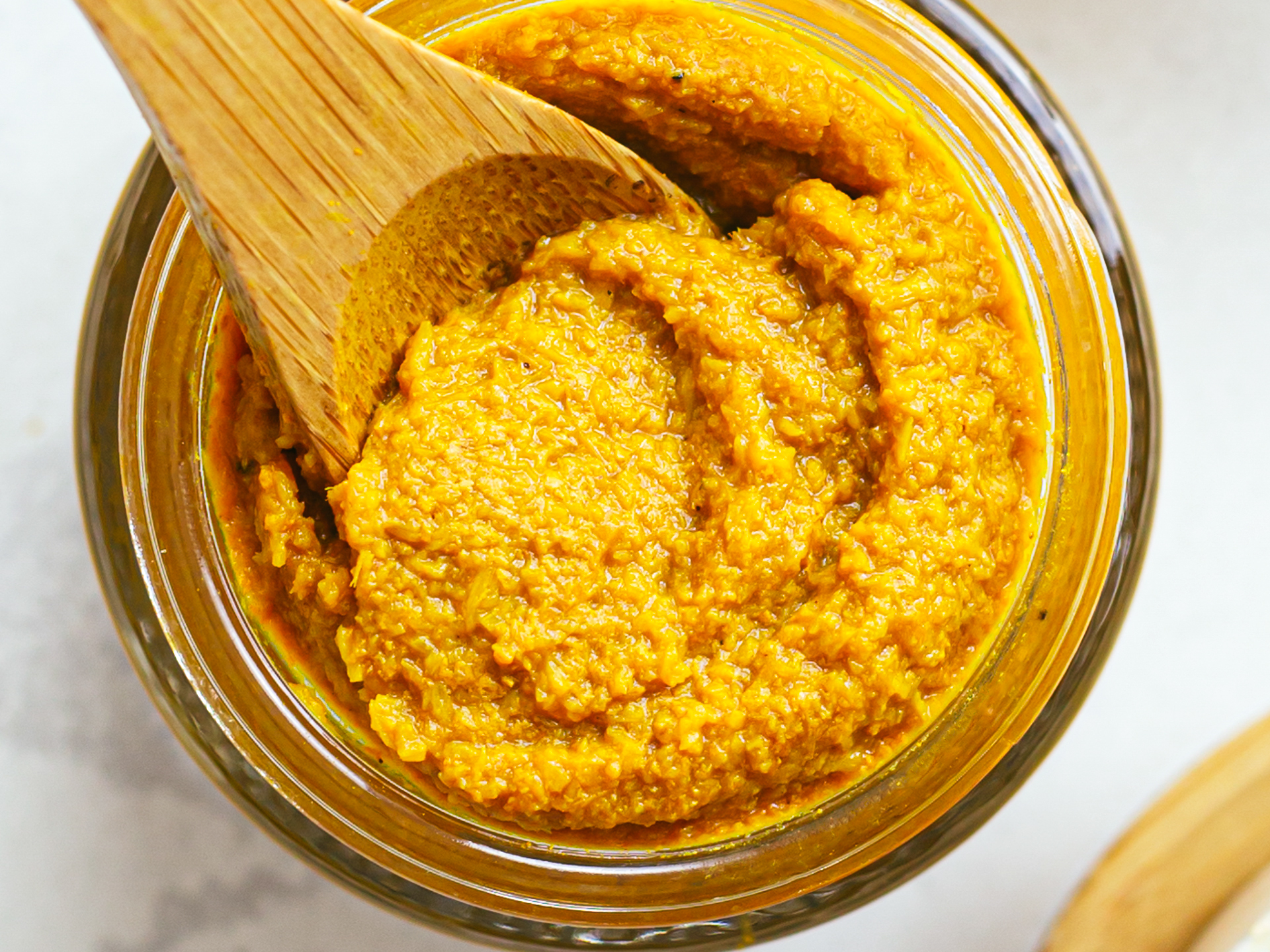Want to make a flavourful Indian curry or a healthy golden latte in a flash? This turmeric paste is the time-saver hack you were looking for. You can prepare it in minutes, store it in a pot, and have it at the ready for all your tasty creations!
Usually made from pureed turmeric root, turmeric paste has an intense yellow-orange, almost golden colour. And that's why it's also known as golden paste.
Golden paste is an amazing multi-tasker you can use for practically any dish, from curries, marinades, and stir-fries to smoothies, bakes, and hot drinks like herbal teas and lattes.
Simply dissolve half or one teaspoon of the paste in sizzling oil, simmering broth, or hot milk and enjoy.
Our turmeric paste recipe is inspired by traditional Indian curry pastes, where ingredients like ginger root and spices are pounded in a mortar into a raw mix.
To keep things easy, we used a blender for blitzing and turmeric powder instead of the fresh root.
Turmeric powder is made from the dried ground root, and it's cheaper, easier to find, and just as healthy!
So, we whizzed turmeric with a splash of water, a dash of salt, and ginger root for bulk, flavour, and extra goodness.
Then, we round it all up with black pepper and a few teaspoons of coconut oil. Pepper and fats are two well-known absorption boosters of curcumin, turmeric's active ingredient!
And to thicken the paste, we simply strained it through a sieve to remove excess juices — no cooking needed.
This makes the recipe faster and also helps retain lots of precious antioxidants!
Yes, turmeric and ginger are laden with antioxidants and also have powerful anti-inflammatory effects.
So, just a teaspoon of this turmeric paste delivers a mighty health boost while infusing your dishes with flavour!
What’s turmeric paste?
Turmeric paste is a raw pureé made from fresh turmeric root, but can also be prepared with turmeric powder.
Turmeric is usually pounded or blended into a paste with other ingredients like ginger and water, plus black pepper and oil.
How do you use turmeric paste?
Use ginger turmeric paste as a tasty base in Indian and Southeast-Asian dishes, like curries, stir-fries, sauces, and marinades, to add a peppery, earthy flavour and deep golden colour.
You usually need one teaspoon of golden paste per person.
Turmeric paste is also good for preparing healthy drinks like an antioxidant smoothie, a soothing herbal tea, and an anti-inflammatory golden latte.
What’s turmeric paste good for?
Made with concentrated turmeric root, turmeric paste can work as a nutritional supplement with powerful anti-inflammatory and antioxidant properties.
A teaspoon of turmeric paste a day can help fight inflammation (especially chronic low-level inflammation and joint inflammation in arthritis) and also prevent age-related diseases.
On top of that, turmeric paste is also a good food supplement for a healthier brain, gut, and immune system.
Can you eat turmeric paste raw?
You don’t have to cook turmeric paste to eat it: so yes, you can have it raw, as long as you pair it with black pepper and a source of fat for better absorption.
However, raw ginger turmeric paste can taste quite spicy, peppery, and earthy, which may be unpleasant for you.
Cooking the paste in a curry or dissolving it in hot water or milk can help tone down its sharp flavour.
Do you make turmeric paste with the powder or fresh turmeric?
Pretty much like ginger puree, turmeric paste is usually made from fresh turmeric root, pounded in a mortar or blended into a pulp.
Still, you can also make turmeric paste with turmeric powder, which is cheaper and easy to find and just as healthy.
Two teaspoons of turmeric powder equals 15 grams or 1/2 oz of fresh root.
When using the powder, as in this recipe, you’ll need a few extra ingredients (like water, ginger, and oil) to add bulk.
How do you make golden latte with turmeric paste?
To make golden milk with turmeric paste:
Heat 200 ml / 8 fl oz of milk (dairy or non-dairy milk) in a pot
Stir half to one teaspoon of paste and bring to a gentle simmer
Optionally tip some ground cinnamon, clove, or cardamom
Sweeten to taste and serve with foamed milk if you like
Do you need coconut oil for turmeric paste?
Coconut oil is not necessary for turmeric paste, as it’s used just as an add-on to help boost turmeric’s curcumin absorption.
As you’d usually consume turmeric paste in a curry or latte, which already contains a source of fat, you can omit the coconut oil and keep the paste recipe oil-free.
If you decide to use oil instead, you can swap coconut oil with other vegetable oils like avocado or flaxseed oil, using about one teaspoon for one small pot of paste.
What can you use turmeric paste for?
Here are some recipe ideas where you can add this ginger turmeric paste:
Ingredients
| Raw Ginger Root | 120 g |
| Turmeric Powder | 2 tbsp |
| Salt | 2 pinch |
| Ground Black Pepper | 1/4 tsp |
| Water | 100 mL |
| Melted Coconut Oil (optional) | 2 tsp |
Step 1
Rinse the ginger root well to help soften its outer skin and use the tip of a spoon (or a knife or vegetable peeler) to peel it off.
Then, roughly chop the peeled ginger into chunks.
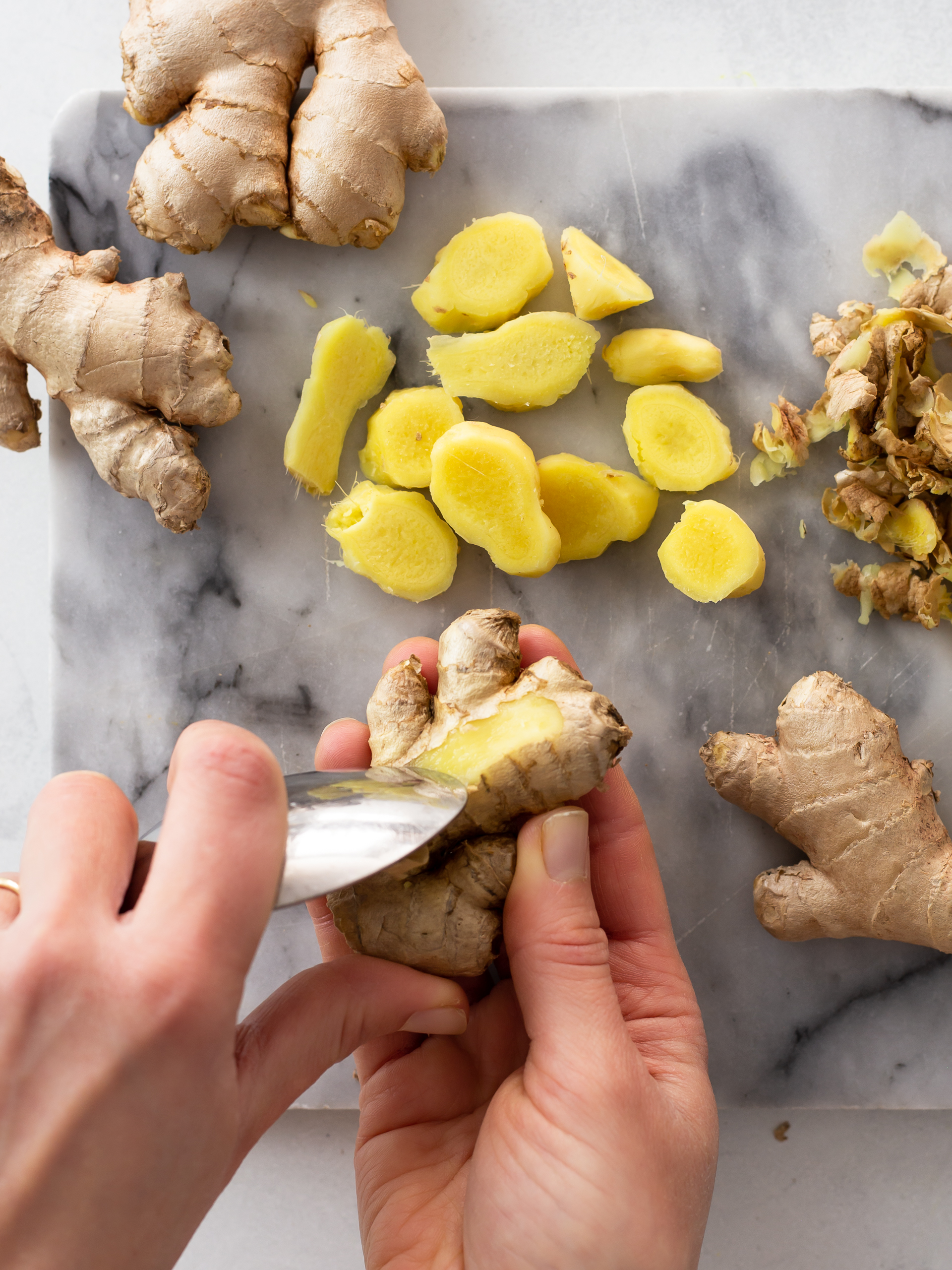
Step 2
Add the prepared ginger to a powerful blender or food processor and tip in the turmeric powder, salt, black pepper, and water.
Blitz all the ingredients long enough to make a deep-orange golden paste that's as smooth as possible.
You may have to scrape the sides of the blender bowl with a spatula a few times between pulses to collect any large ginger bits.
At this point, the turmeric paste will be a bit runny as you used water (but water helps blend it smoothly).
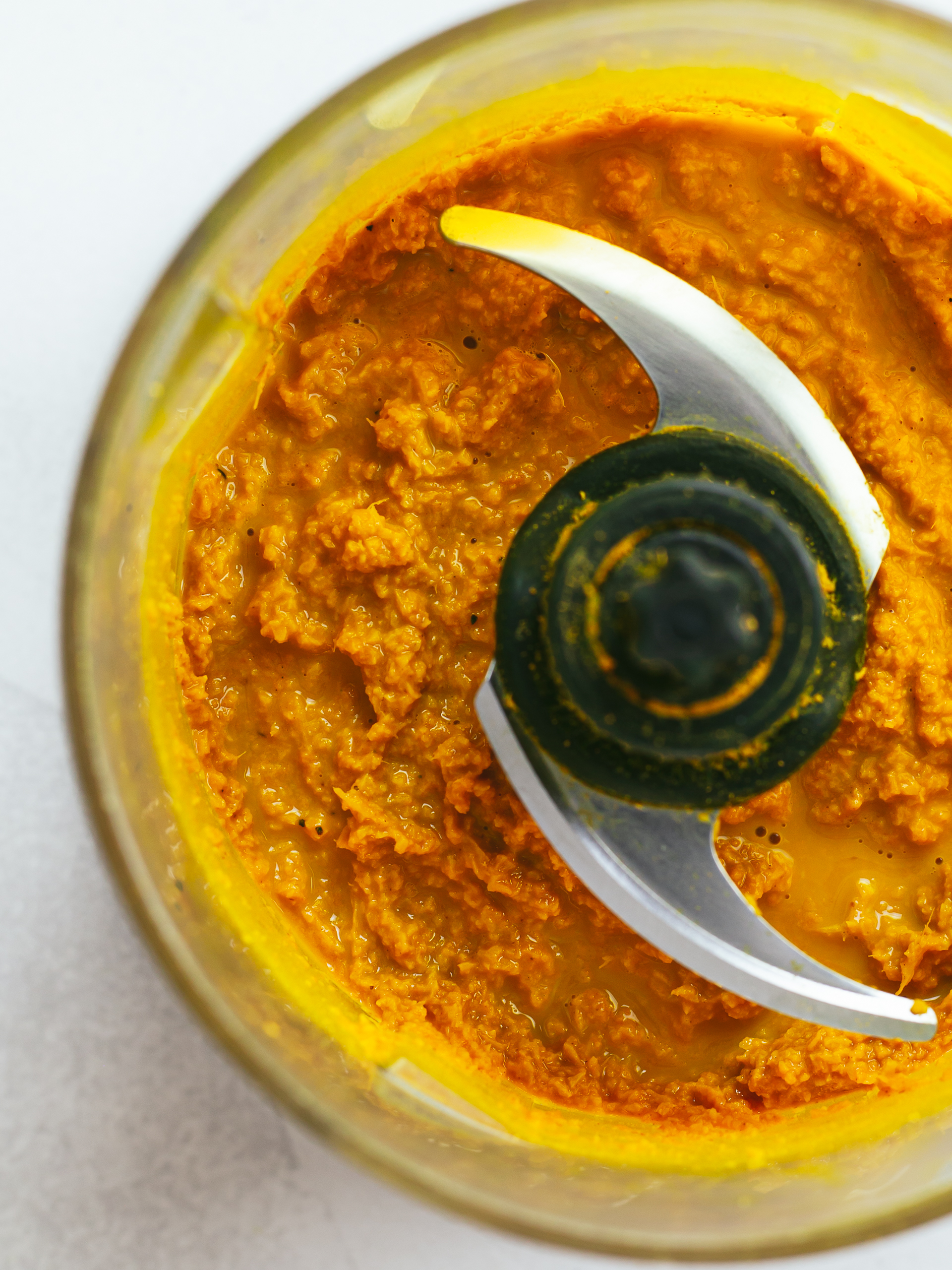
Step 3
To remove excess water and make the paste more compact and scoopable, strain the turmeric paste through a fine-mesh sieve, squeezing the pulp with the back of a spoon.
Collect the juice in a cup, but don't throw it away! You can dilute it with lemon and orange juice to make a healthy turmeric shot.
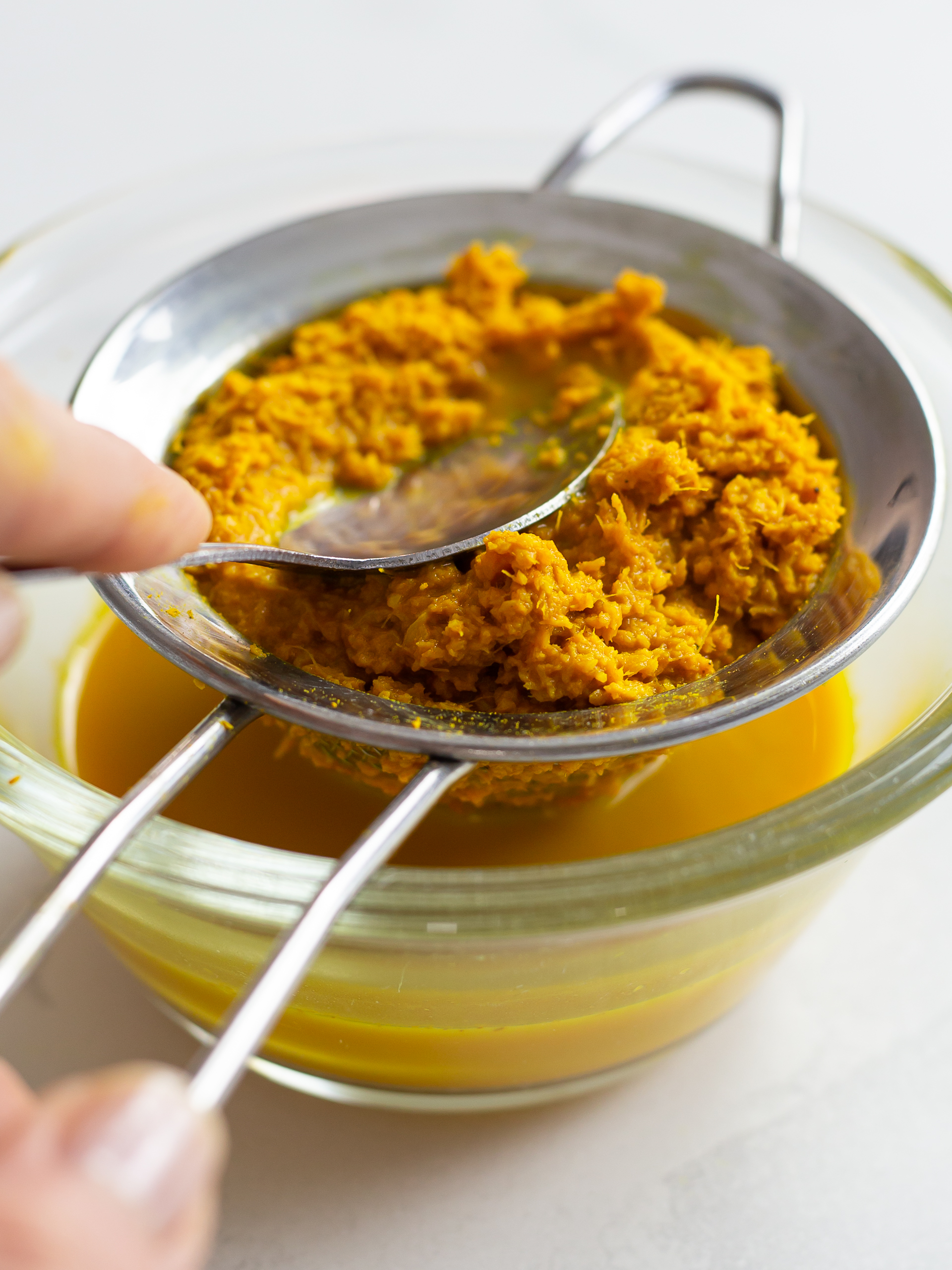
Step 4
Transfer the golden paste to a cup or jar, add melted coconut oil, and stir until it's fully incorporated.
Coconut oil contains fats which help boost turmeric's absorption, but it's optional.
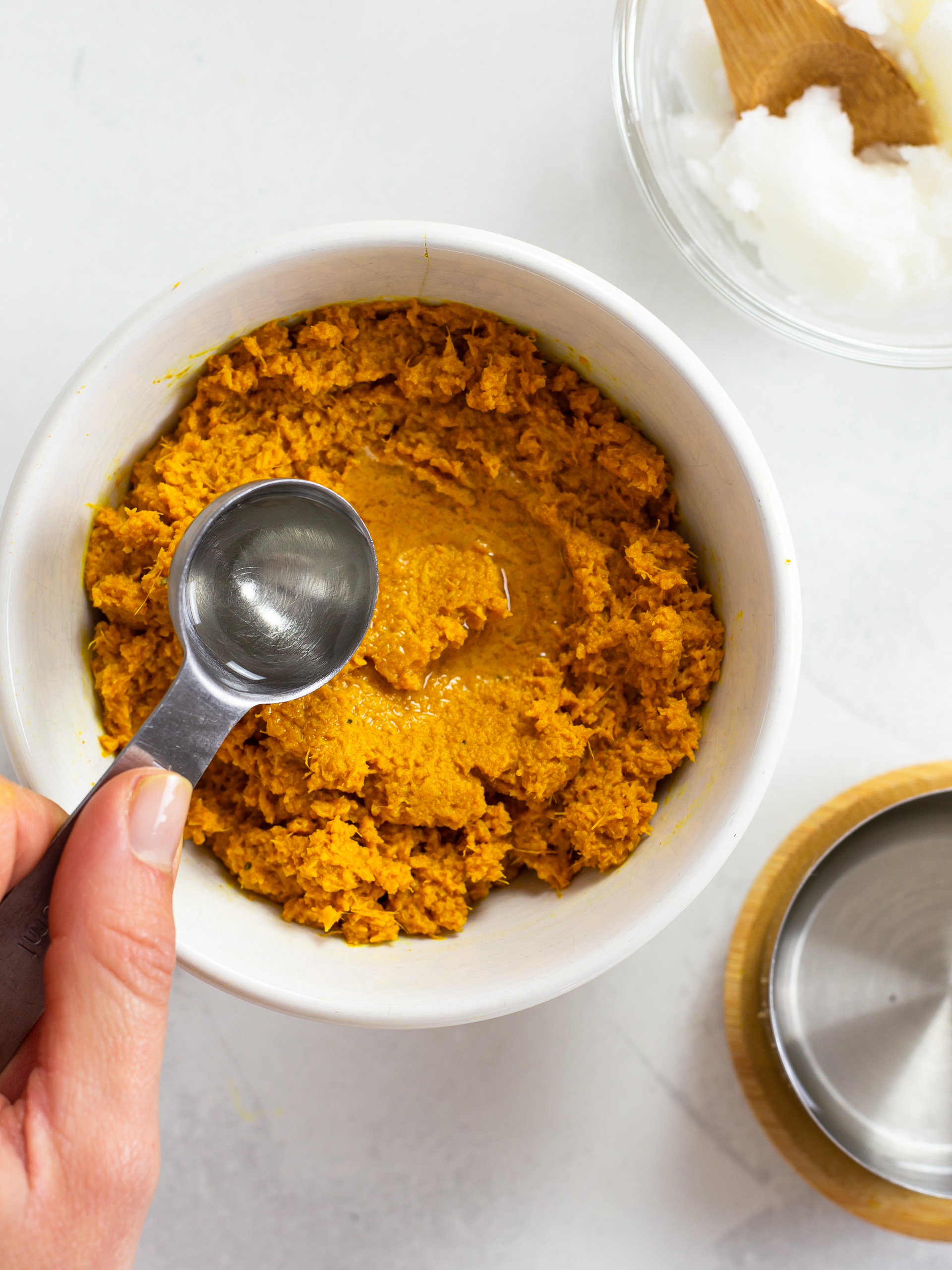
Step 5
Store the golden paste in a sealed jar or container in the fridge for up to 10 days.
To use it, stir 1/2 to 1 ½ teaspoons of turmeric paste into curries, soups, and sauces or hot drinks like teas and lattes.
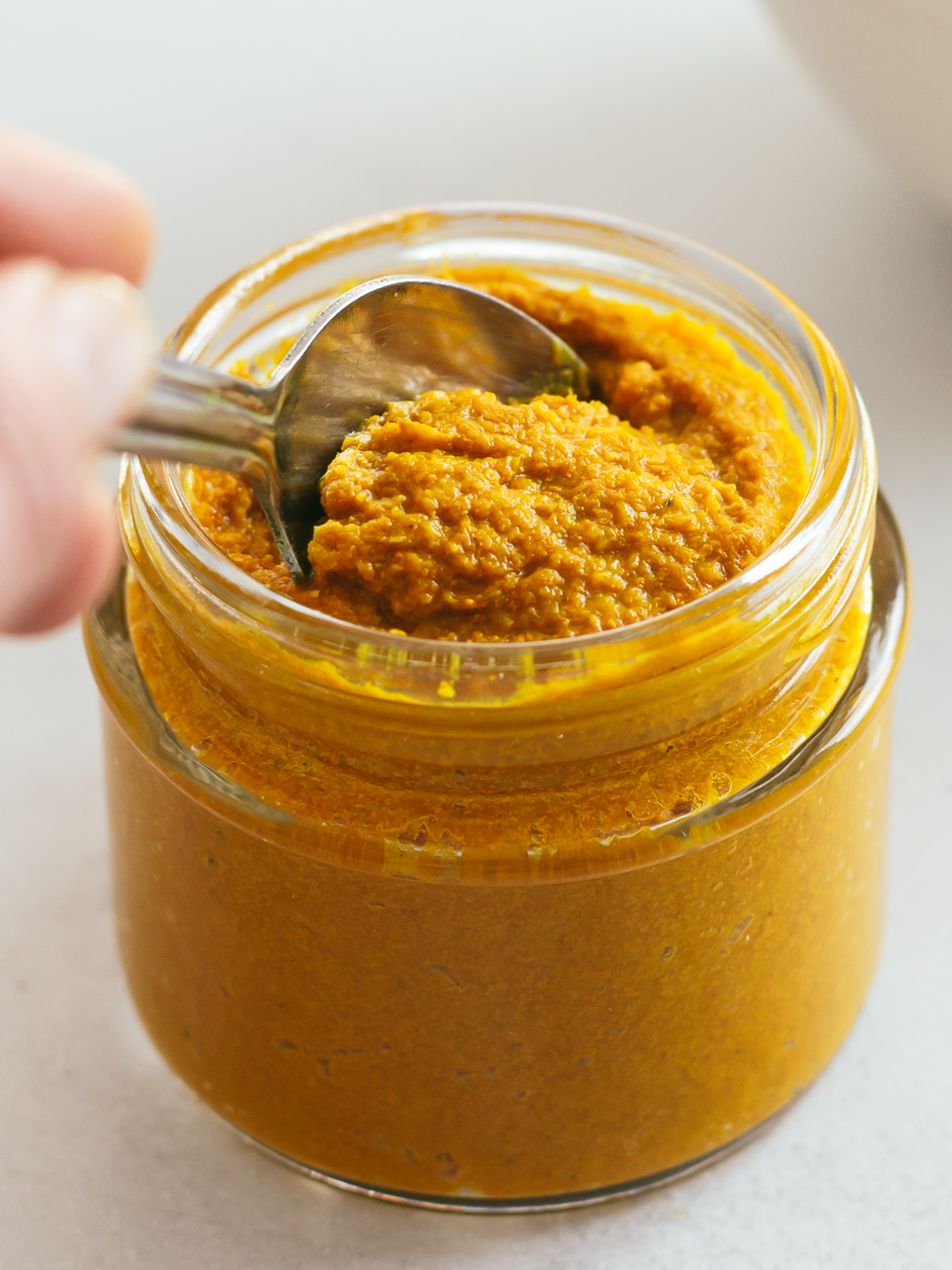
Tips
The default ingredients yield two small pots of paste: you can use one for making lattes, adding cinnamon, clove, and cardamom to taste, and the other for preparing curries adding garlic, chillies, and cumin.
You can freeze the paste for 3 months in ice cube trays: fill each ice cube cell with a teaspoon of paste and top it up with water.
